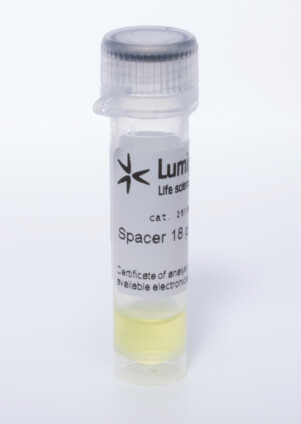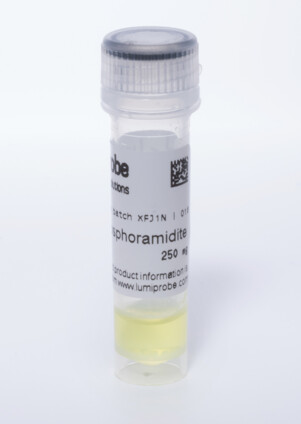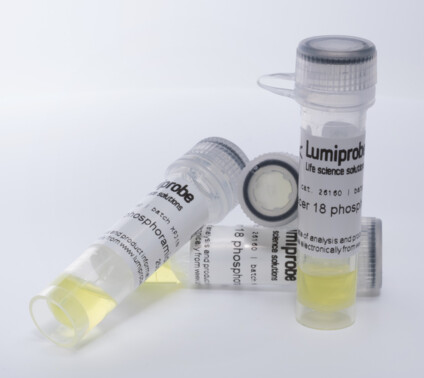- Products
- DNA
- Phosphoramidites
- Hexaethylene glycol phosphoramidite
Hexaethylene glycol phosphoramidite
| 货号 | 规格 | 价格 | 货期 |
|---|---|---|---|
| 26160 | 250 mg | 70.00$ | in stock |
| 46160 | 1 g | 210.00$ | in stock |
Spacer phosphoramidite 18 (hexaethylene glycol phosphoramidite) is an amidite reagent for oligonucleotide synthesis. It provides a long hydrophilic linker that can be used for the synthesis of Scorpion-type qPCR probes, for spacing biotin from oligo strand, and for other applications requiring spatial separation of modifier and oligo.
间隔亚磷酰胺 18(六甘醇亚磷酰胺)是一种用于寡核苷酸合成的亚酰胺试剂。 它提供了一个长的亲水性接头,可用于合成 Scorpion 型 qPCR 探针,用于将生物素与寡核苷酸链分开,以及用于需要修饰剂和寡核苷酸空间分离的其他应用。
Hexaethylene glycol phosphoramidite相关产品
DMS(O)MT aminolink C6
An amidite for the introduction of amino group.
用于引入氨基的亚酰胺。
Alkyne Phosphoramidite, 5′-terminal
Alkyne phosphoramidite for the synthesis of oligonucleotides ready for Click chemistry.
用于合成寡核苷酸的炔亚磷酰胺,可用于点击化学。
Inosine (dI) phosphoramidite
Dimethoxytrityl deoxyinosine (Dmt-dI) phosphoramidite for the synthesis of modified DNA oligonucleotides.
二甲氧基三苯甲基脱氧肌苷 (Dmt-dI) 亚磷酰胺,用于合成修饰的 DNA 寡核苷酸。
General properties
| Appearance: | colorless/yellowish oil |
| Molecular weight: | 784.92 |
| CAS number: | 125607-09-2 |
| Molecular formula: | C42H61N2O10P |
| Solubility: | good in most organic solvents |
| Quality control: | NMR 1H, 31P, HPLC-MS (95%), testing in oligo sythesis |
| Storage conditions: | Storage: 12 months after receival at -20°C in the dark. Transportation: at room temperature for up to 3 weeks. Avoid prolonged exposure to light. Desiccate. |
| MSDS: | Download |
| Product specifications |
Oligo synthesis details
| Diluent: | acetonitrile |
| Coupling conditions: | standard coupling, identical to normal nucleobases |
| Deprotection conditions: | identical to protected nucleobases |




